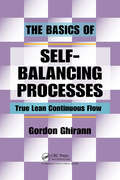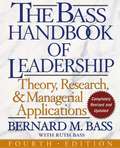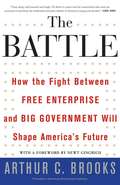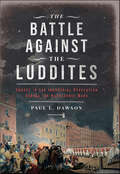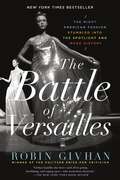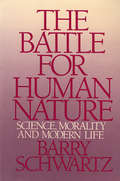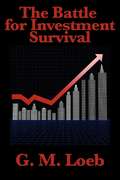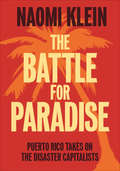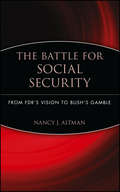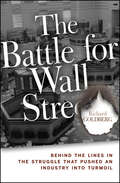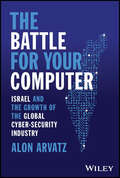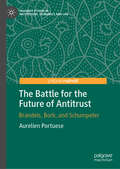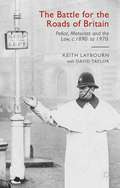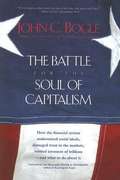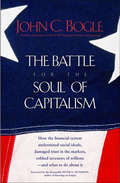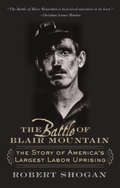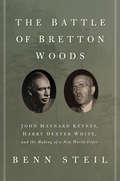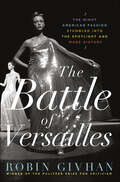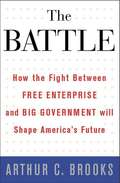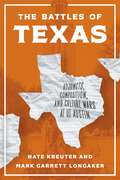- Table View
- List View
The Basics of Self-Balancing Processes: True Lean Continuous Flow
by Gordon GhirannSelf-Balancing is not just a tweak or change to assembly line balancing, but a completely transformed method for achieving continuous flow. Among the reasons you should try Self-Balancing is that you can expect a productivity improvement of at least 30 percent with improvements of 50-60 percent quite common.Using a well-tested method for successful improvements initiated by the author, The Basics of Self-Balancing Processes: True Lean Continuous Flow is the first book to explain how to achieve continuous flow in both simple and complex manufacturing environments. It describes how to recognize and resolve weak links to ensure continuous flow in your manufacturing operations.The book offers rules, tools, and guidelines to help you not only solve problems at the root, but even eliminate them before they start. It reviews the shortcomings of traditional assembly line balancing and walks readers through the new paradigm of Self-Balancing.The text includes a comprehensive overview that demonstrates the power, flexibility, and breakthroughs possible with this method. Offering solutions to the shortcomings associated with standard line balancing including inventory buffers, variation, and operator pace it provides you with the tools and understanding required to deal with batch and off-line processes, debug your line, arrange your parts and tools, and design your own Self-Balanced cells.Watch Gordon Ghirann discuss how his book can increase the productivity of your business. http://www.youtube.com/watch?v=yte0622XbcI&feature=youtu.be
The Basque Contention: Ethnicity, Politics, Violence (Europa Country Perspectives)
by Ludger MeesTo the outside world, for some half a century, the words ‘Basque Country’ have provoked an almost instant association with the Euskadi Ta Askatasuna (ETA, Basque Homeland and Liberty) separatist group and violent conflict. The Basque Contention: Ethnicity, Politics, Violence attempts to undo this simplistic correlation and, for the first time, provide a definitive history of the wider political issues at the heart of the Basque Country. Drawing on three decades of research on Basque nationalism, Ludger Mees weaves together the various historical and contemporary strands of this contention: from the late medieval kingdoms of Spain and France and the first articulations of a Basque ethno-particularism, to the dissolution of ETA in 2018, and all manner of dictatorships, conflict, peace, civil war, political intrigue, hope and failure in-between. For anyone who has ever wanted to gain an insight into the Basque Country beyond the headlines of ETA and grasp the complexity of its relationship with Spain, France and indeed itself, this volume provides a detailed, yet digestible, basis for such an understanding.
The Basque Country: Strategy for Economic Development
by Michael E. Porter Christian H.M. Ketels Jesus M ValdalisoThe Basque country, with a population of 2.1 million and covering 7,233 square kilometers, is an autonomous region located in the north of Spain, physically separated from it by the Pyrenees mountains. Presents the history of the region--highly prosperous at the turn of the 20th century, but nearing bankruptcy by the 1950s. By 2001, the Basque GDP per capita had risen to a level well ahead of Spain and most European countries. At the same time that the region was enjoying the spoils of admirably executed cluster initiatives, it was being threatened by the destabilizing violence of the Basque separatist extreme, a slowing global economy, and an always-precarious balance of power between the Basque's own government and the government of Spain.
The Bass Handbook of Leadership: Theory, Research, and Managerial Applications
by Bernard M. Bass Ruth BassFor thirty-three years and through three editions, Bass & Stogdill's Handbook of Leadership has been the indispensable bible for every serious student of leadership. Since the third edition came out in 1990, the field of leadership has expanded by an order of magnitude. This completely revised and updated fourth edition reflects the growth and changes in the study of leadership over the past seventeen years, with new chapters on transformational leadership, ethics, presidential leadership, and executive leadership. Throughout the Handbook, the contributions from cognitive social psychology and the social, political, communications, and administrative sciences have been expanded. As in the third edition, Bernard Bass begins with a consideration of the definitions and concepts used, and a brief review of some of the betterknown theories. Professor Bass then focuses on the personal traits, tendencies, attributes, and values of leaders and the knowledge, intellectual competence, and technical skills required for leadership. Next he looks at leaders' socioemotional talents and interpersonal competencies, and the differences in these characteristics in leaders who are imbued with ideologies, especially authoritarianism, Machiavellianism, and self-aggrandizement. A fuller examination of the values, needs, and satisfactions of leaders follows, and singled out for special attention are competitiveness and the preferences for taking risks. In his chapters on personal characteristics, Bass examines the esteem that others generally accord to leaders as a consequence of the leaders' personalities. The many theoretical and research developments about charisma over the past thirty years are crucial and are explored here in depth. Bass has continued to develop his theory of transformational leadership -- the paradigm of the last twenty years -- and he details how it makes possible the inclusion of a much wider range of phenomena than when theory and modeling are limited to reinforcement strategies. He also details the new incarnations of transformational leadership since the last edition. Bass has greatly expanded his consideration of women and racial minorities, both of whom are increasingly taking on leadership roles. A glossary is included to assist specialists in a particular academic discipline who may be unfamiliar with terms used in other fields. Business professors and students, executives in every industry, and politicians at all levels have relied for years on the time-honored guidance and insight afforded by the Handbook.
The Battle
by Arthur C. BrooksAmerica faces a new culture war. It is not a war about guns, abortions, or gays-rather it is a war against the creeping changes to our entrepreneurial culture, the true bedrock of who we are as a people. The new culture war is a battle between free enterprise and social democracy. Many Americans have forgotten the evils of socialism and the predations of the American Great Society’s welfare state programs. But, as American Enterprise Institute’s president Arthur C. Brooks reveals in The Battle, the forces for social democracy have returned with a vengeance, expanding the power of the state to a breathtaking degree. The Battle offers a plan of action for the defense of free enterprise; it is at once a call to arms and a crucial redefinition of the political and moral gulf that divides Right and Left in America today. The battle is on, and nothing less than the soul of America is at stake.
The Battle Against the Luddites: Unrest in the Industrial Revolution During the Napoleonic Wars
by Paul L. DawsonAs the columns of French infantry marched up the slopes of the Mont St Jean at Waterloo, the British heavy cavalry, the Royal Scots Greys to the fore, crashed into the packed ranks of the enemy. This was not the first time the Greys had drawn their swords during the Napoleonic Wars – but it was their first against Napoleon’s troops. Three years earlier they had attacked workers in Halifax protesting at the introduction of machinery in the wool trade. Taking their name from Ned Ludd, who had smashed up knitting frames in Nottingham, the Luddites saw the emergence of mechanization as a threat to their livelihood, with machines replacing men. In response they took matters into their own hands by wrecking the new equipment. Industrial unrest had gathered pace throughout the 18th century and exploded in an unpresented wave of violence in 1799. Outbreaks of machine-breaking developed rapidly into strikes in a battle of capital against labor. A court battle ensued, culminating in new legislation in 1806 that backed the capitalists. This act, coupled with the impact of the Continental system introduced by Napoleon, which closed European and American ports to British merchants, heralded the largest economic depression of the era. Famine, pestilence and rising employment all fueled the fires of Luddism. Months of violence swept across the West Midlands, Lancashire and Yorkshire which saw one factory boss murdered; other factory owners began shooting protesting workers. The disturbances resulted in the mobilizing of thousands of regular soldiers – at one time there were as many British soldiers fighting the Luddites than there were fighting Napoleon on the Iberian Peninsula. As well as exploring these events, Paul L. Dawson also uncovers the origins of Luddism and their allies in the middle classes. The Napoleonic Wars marked the end of centuries old way of life in agriculture, textile production and the wider economy. The dramatic changes in Britain between 1790 and 1815 created a unique set of social grievances by those left behind by the unprecedented changes that were surging through the Britain which exploded into bitter fighting across large swathes of the country. With present day concerns over computerization replacing labor, this is a story that echoes down the centuries.
The Battle Of Versailles: The Night American Fashion Stumbled Into The Spotlight And Made History
by Robin GivhanOn November 28, 1973, the world's social elite gathered at the Palace of Versailles for an international fashion show. By the time the curtain came down on the evening's spectacle, history had been made and the industry had been forever transformed. This is that story.<P><P> Conceived as a fund-raiser for the restoration of King Louis XIV's palace, in the late fall of 1973, five top American designers faced off against five top French designers in an over-the-top runway extravaganza. An audience filled with celebrities and international jet-setters, including Princess Grace of Monaco, the Duchess of Windsor, Paloma Picasso, and Andy Warhol, were treated to an opulent performance featuring Liza Minnelli, Josephine Baker, and Rudolph Nureyev. What they saw would forever alter the history of fashion.<P> The Americans at the Battle of Versailles– Oscar de la Renta, Bill Blass, Anne Klein, Halston, and Stephen Burrows – showed their work against the five French designers considered the best in the world – Yves Saint Laurent, Hubert de Givenchy, Pierre Cardin, Emanuel Ungaro, and Marc Bohan of Christian Dior. Plagued by in-fighting, outsized egos, shoestring budgets, and innumerable technical difficulties, the American contingent had little chance of meeting the European's exquisite and refined standards. But against all odds, the American energy and the domination by the fearless models (ten of whom, in a groundbreaking move, were African American) sent the audience reeling. By the end of the evening, the Americans had officially taken their place on the world's stage, prompting a major shift in the way race, gender, sexuality, and economics would be treated in fashion for decades to come. As the curtain came down on The Battle of Versailles, American fashion was born; no longer would the world look to Europe to determine the stylistic trends of the day, from here forward, American sensibility and taste would command the world's attention.<P> Pulitzer-Prize winning fashion journalist Robin Givhan offers a lively and meticulously well-researched account of this unique event. The Battle of Versailles is a sharp, engaging cultural history; this intimate examination of a single moment shows us how the world of fashion as we know it came to be.
The Battle for Britain's Gold Standard in 1931 (Routledge Library Editions: The Gold Standard #4)
by Diane B KunzThis book, originally published in 1987 sets the British political and financial crisis of 1931 in an international context by concentrating on the bankers who were primarily responsible for leading the fight to protect sterling in a world context. 1931 marks the point at which the near-autonomy which bankers had achieved during the 1920s began to decline and 1931 was thus the last attempt of important groups to return Britain to the Edwardian era. The reasons for their failure to do this are still pertinent in today's international financial climate and this study provides a definitive account of an eciting episode in British politics.
The Battle for Hearts and Minds: Using Soft Power to Undermine Terrorist Networks
by Alexander T. J. LennonAlthough military operations have dominated media coverage of the war on terrorism, a much broader array of policy options may hold the key to reducing the appeal of global terrorist networks, particularly in economically destitute areas. These strategies involve the use of "soft power," a term first used by political scientist Joseph Nye in a 1990 article in Foreign Policy to describe nonmilitary strategies to shape international relations and behavior. The Battle for Hearts and Minds discusses four aspects of soft power. The first section of the book considers failed or failing states as havens for transnational terrorist networks, and examines the most effective ways to build stable nations in unstable regions, including focused looks at Afghanistan and Sierra Leone. The second section explores post conflict reconstruction, including in-depth examinations of security, justice and reconciliation, opportunities for achieving socioeconomic well-being, and increased participation in government. The third section examines public diplomacy, asking whether the United States needs new policies or simply a new image to increase its appeal in the Arab and Muslim world. The final section of the book looks at foreign assistance, and assesses the potential of the current administration's "Millennium Challenge Account" (or as one contributor puts it, "Compassionate Conservatism Meets Global Poverty") to combat poverty, increase democracy, and reduce the appeal of terror. The Battle for Hearts and Minds presents a balanced assessment of the role that nonmilitary options can play against transnational terrorist networks.
The Battle for Human Nature: Science, Morality and Modern Life
by Barry Schwartz"Provocative and richly textured. . . .Schwartz's analyses of the inadequacies of contemporary scientific views of human nature are compelling, but the consequences are even more worthy of note." --Los Angeles Times Out of the investigations and speculations of contemporary science, a challenging view of human behavior and society has emerged and gained strength. It is a view that equates "human nature" utterly and unalterably with the pursuit of self-interest. Influenced by this view, people increasingly appeal to natural imperatives, instead of moral ones, to explain and justify their actions and those of others.
The Battle for Investment Survival
by G. M. LoebA reader of one of my earlier discussions asked-"Have you ever tried out the ideas outlined in your book?" My reply was to the effect that the ideas were tried out first, and the book written afterward. Any earner who earns more than he can spend is automatically an investor. It doesn't matter in the slightest whether he wants to be or not, or even whether he realizes that he is investing. Storing present purchasing power for use in the future is investing, no matter in what form it's put away. Some popular and common forms include money itself, government bonds, savings bank deposits, real estate, commodities, securities of all types, diamonds and where and when it's legal, gold.
The Battle for Paradise: Puerto Rico Takes on the Disaster Capitalists
by Naomi KleinFearless necessary reporting . . . Klein exposes the &‘battle of utopias&’ that is currently unfolding in storm-ravaged Puerto Rico&” (Junot Díaz, author of The Brief Wondrous Life of Oscar Wao) &“We are in a fight for our lives. Hurricanes Irma and María unmasked the colonialism we face in Puerto Rico, and the inequality it fosters, creating a fierce humanitarian crisis. Now we must find a path forward to equality and sustainability, a path driven by communities, not investors. And this book explains, with careful and unbiased reporting, only the efforts of our community activists can answer the paramount question: What type of society do we want to become and who is Puerto Rico for?&” —Carmen Yulín Cruz, Mayor of San Juan, Puerto Rico In the rubble of Hurricane Maria, Puerto Ricans and ultrarich &“Puertopians&” are locked in a pitched struggle over how to remake the island. In this vital and startling investigation, bestselling author and activist Naomi Klein uncovers how the forces of shock politics and disaster capitalism seek to undermine the nation&’s radical, resilient vision for a &“just recovery.&” All royalties from the sale of this book in English and Spanish go directly to JunteGente, a gathering of Puerto Rican organizations resisting disaster capitalism and advancing a fair and healthy recovery for their island. &“Klein chronicles the extraordinary grassroots resistance by the Puerto Rican people against neoliberal privatization and Wall Street greed in the aftermath of the island&’s financial meltdown, of hurricane devastation, and of Washington&’s imposition of an outside control board over the most important U.S. colony.&” —Juan González, cohost of Democracy Now! and author of Harvest of Empire: A History of Latinos in America
The Battle for Social Security: From FDR's Vision To Bush's Gamble
by Nancy J. AltmanThis book illuminates the politics and policy of the current struggle over Social Security in light of the program's compelling history and ingenious structure. After a brief introduction describing the dramatic response of the Social Security Administration to the 9/11 terrorist attack, the book recounts Social Securityâ??s lively history. Although President Bush has tried to convince Americans that Social Security is designed for the last century and unworkable for an aging population, readers will see that the President's assault is just another battle in a longstanding ideological war. Prescott Bush, the current Presidentâ??s grandfather, remarked of FDR, "The only man I truly hated lies buried in Hyde Park." The book traces the continuous thread leading from Prescott Bush and his contemporaries to George W. Bush and others who want to undo Social Security. The book concludes with policy recommendations which eliminate Social Security's deficit in a manner consistent with the program's philosophy and structure.
The Battle for Wall Street
by Richard GoldbergAn insider's look at the changing balance of power on Wall StreetThe Battle for Wall Street follows the struggle for power between two giants: the sellers, traditional commercial and investments banks; and the buyers, upstart hedge funds, private equity firms and the like. The battle is about winning the hearts, minds, and - yes, the wallets - of global investors. This battle is still running its course, and with the insights of industry veteran Richard Goldberg, who has had a front row seat, readers will gain a detailed understanding as to what, exactly, is going on within this dynamic arena, specifically the forces behind the shift of power from the old sell side gatekeepers to the new buy side players. The book will play out in three acts: Act One will examine the instruments of change - liquidity and financial technology - along with their influence on the sell and buy sides. Act Two will look at the agents of change - hedge funds, private equity, financial entrepreneurs, endowments, exchanges and sovereign wealth funds - and their impact on the sell and buy sides. In Act Three, Goldberg will take out his crystal ball and walk through the strategic implications for the winners and losers in this battle, against the dramatic backdrop of the subprime mortgage crisis and the resulting shakeup of global firms like Bear Stearns.But Wall Street isn't simply about institutions or corporate battles. It's a landscape dominated by personalities. Goldberg's unique access to major players will bring this book to life with amazing anecdotes and stories about the financial generals who have left their mark in The Battle for Wall Street.
The Battle for Your Computer: Israel and the Growth of the Global Cyber-Security Industry
by Alon ArvatzDiscover the extraordinary realities of the world’s most advanced cybersecurity companies and tech In The Battle for Your Computer: Israel and the Growth of the Global Cyber-Security Industry, Israeli Defense Force (IDF) cyberwarfare veteran and tech product leader Alon Arvatz examines the “why” and the “how” of the extraordinarily strong connection between Israel’s elite cyber military unit and that country’s booming offensive and defensive cybersecurity industry. In the book, you’ll explore the central role played by Israel in the global fight for cybersecurity supremacy. Featuring interviews with some of the world’s leading cybersecurity professionals and leaders, The Battle for Your Computer explains how the IDF’s “Unit 8200” became the globe’s most fruitful incubator of cyber technologies. You’ll also find: Explanations of how the technologies that protect your own computers at home and at work probably began their lives in IDF personnel or equipment The stories of the men and women working to protect Israel and how they pivoted to protecting her technology against attack Answers to fascinating questions like: How does an offensive cyber company decide to whom to sell its tech?An endlessly engrossing take on an equally engrossing subject, The Battle for Your Computer is a must-read for laypeople and cyber experts alike.
The Battle for the Future of Antitrust: Brandeis, Bork, and Schumpeter (Palgrave Studies in Institutions, Economics and Law)
by Aurelien PortueseIn an era where technology is evolving at breakneck speed and populist movements are reshaping political landscapes, the regulation of market participants stands at a critical crossroads. The future of antitrust — once a relatively stable domain of law and policy — is now caught in a fierce battle between traditional doctrines and emerging approaches that seek to address the new realities of our time. This book delves into this struggle, offering a thought-provoking exploration of how antitrust laws have evolved, how they are being challenged, and what is at stake for the future. Through a unique lens that juxtaposes the legacies of Louis Brandeis, Robert Bork, and Joseph Schumpeter, this book offers an insightful analysis of the forces shaping the future of antitrust. By tracing the historical evolution of antitrust law through economic theory and examining the ongoing debates that define today’s regulatory environment, the author provides a comprehensive yet accessible guide to the competing schools of thought in this critical field. This is a highly valuable resource for a diverse readership interested in the future of competition law and the broader regulation of innovation, from legal experts to students of law and economics, as well as professionals and policymakers navigating the complexities of market regulation.
The Battle for the Roads of Britain
by David Taylor Keith LaybournThe onset of the automobile, both cars and other vehicles, on British roads brought about a seismic change in the social, economic and political history of Britain. Cars fundamentally challenged the established democracy of the road by forcing the authorities to channel the pedestrian, and children, out of the way of the unforgiving automobile and educating them in exercising road safety. They also forced the police to implement the three Es of 'Enforcement, Engineering and Education' – enforcing the law of the road, pressing for new technology for signals and other technologies, and educating school children - in an impartial attempt to ensure that life was protected. In this process, the police should not be seen as the tools of the motorists, middle class or working class, but as the impartial enforcers of legislation, introducing as such the 'policeman-state'. Consequently, policing fundamentally changed in Britain between 1900 and 1970, as the police moved from their 'feet to their seats' in controlling traffic as British policing became more integrated and introduced new technology and modern systems.
The Battle for the Soul of Capitalism
by John C. BogleAn astute, longtime observer of the business world, the founder and former CEO of Vanguard mutual funds explains the failures of the American financial system and the abuses that have plagued it in recent years. More important, John C. Bogle offers a host of practical reforms to restore integrity to corporate and investment America and to protect small investors' interests.
The Battle for the Soul of Capitalism: How the Financial System Undermined Social Ideals, Damaged Trust in the Markets, Robbed Investors of Trillions—and What to Do About It (Playaway Adult Nonfiction Ser.)
by John C. BogleThe legendary founder of Vanguard &“presents an insider&’s view of what&’s wrong with corporate America and what can be done to improve it&” (Burton G. Malkiel, author of A Random Walk Down Wall Street).New York Times-bestselling author of Enough and The Little Book of Common Sense Investing John Bogle has seen firsthand the innermost workings—and grotesque abuses—of the financial industry, and is renowned as an advocate for the small investor and for the restoration of integrity to the system. He knows that a trustworthy business and financial complex is essential to America&’s continuing leadership in the world and to social and economic progress at home. In this book he reveals what went wrong and how we lost our way—and more importantly, how we can right our course. He argues for a return to a governance structure in which owners&’ capital that has been put at risk is used in their interests rather than in the interests of corporate and financial managers. Given that ownership is now consolidated in the hands of relatively few large mutual and pension funds, the specific reforms Bogle details in this book are essential as well as practical—and should be considered by every investor, analyst, Wall Streeter, policy maker, and businessperson. &“Deserves attention in the precincts of power.&”—Publishers Weekly
The Battle of Blair Mountain: The Story of America's Largest Labor Uprising
by Robert ShoganVeteran journalist Shogan (government, Johns Hopkins U.) tells how 10,000 coal miners in West Virginia took up arms in 1921 against the brutal mine owners, and stood off the company goons and local government forces protecting the bosses for ten days until the US government sent troops to suppress the uprising. Annotation ©2004 Book News, Inc., Portland, OR (booknews.com)
The Battle of Bretton Woods: John Maynard Keynes, Harry Dexter White, and the Making of a New World Order
by Benn SteilA sweeping history of the drama, intrigue, and rivalry behind the creation of the postwar economic orderWhen turmoil strikes world monetary and financial markets, leaders invariably call for 'a new Bretton Woods' to prevent catastrophic economic disorder and defuse political conflict. The name of the remote New Hampshire town where representatives of forty-four nations gathered in July 1944, in the midst of the century's second great war, has become shorthand for enlightened globalization. The actual story surrounding the historic Bretton Woods accords, however, is full of startling drama, intrigue, and rivalry, which are vividly brought to life in Benn Steil's epic account.Upending the conventional wisdom that Bretton Woods was the product of an amiable Anglo-American collaboration, Steil shows that it was in reality part of a much more ambitious geopolitical agenda hatched within President Franklin D. Roosevelt's Treasury and aimed at eliminating Britain as an economic and political rival. At the heart of the drama were the antipodal characters of John Maynard Keynes, the renowned and revolutionary British economist, and Harry Dexter White, the dogged, self-made American technocrat. Bringing to bear new and striking archival evidence, Steil offers the most compelling portrait yet of the complex and controversial figure of White—the architect of the dollar's privileged place in the Bretton Woods monetary system, who also, very privately, admired Soviet economic planning and engaged in clandestine communications with Soviet intelligence officials and agents over many years.A remarkably deft work of storytelling that reveals how the blueprint for the postwar economic order was actually drawn, The Battle of Bretton Woods is destined to become a classic of economic and political history.
The Battle of Versailles: The Night American Fashion Stumbled into the Spotlight and Made History
by Robin GivhanOn November 28, 1973, the world's social elite gathered at the Palace of Versailles for an international fashion show. By the time the curtain came down on the evening's spectacle, history had been made and the industry had been forever transformed. This is that story.Conceived as a fund-raiser for the restoration of King Louis XIV's palace, in the late fall of 1973, five top American designers faced off against five top French designers in an over-the-top runway extravaganza. An audience filled with celebrities and international jet-setters, including Princess Grace of Monaco, the Duchess of Windsor, Paloma Picasso, and Andy Warhol, were treated to an opulent performance featuring Liza Minnelli, Josephine Baker, and Rudolph Nureyev. What they saw would forever alter the history of fashion.The Americans at the Battle of Versailles– Oscar de la Renta, Bill Blass, Anne Klein, Halston, and Stephen Burrows – showed their work against the five French designers considered the best in the world – Yves Saint Laurent, Hubert de Givenchy, Pierre Cardin, Emanuel Ungaro, and Marc Bohan of Christian Dior. Plagued by in-fighting, outsized egos, shoestring budgets, and innumerable technical difficulties, the American contingent had little chance of meeting the European's exquisite and refined standards. But against all odds, the American energy and the domination by the fearless models (ten of whom, in a groundbreaking move, were African American) sent the audience reeling. By the end of the evening, the Americans had officially taken their place on the world's stage, prompting a major shift in the way race, gender, sexuality, and economics would be treated in fashion for decades to come. As the curtain came down on The Battle of Versailles, American fashion was born; no longer would the world look to Europe to determine the stylistic trends of the day, from here forward, American sensibility and taste would command the world's attention. Pulitzer-Prize winning fashion journalist Robin Givhan offers a lively and meticulously well-researched account of this unique event. The Battle of Versailles is a sharp, engaging cultural history; this intimate examination of a single moment shows us how the world of fashion as we know it came to be.
The Battle: How the Fight Between Free Enterprise and Big Government Will Shape America's Future
by Arthur C. BrooksBrooks, president of the American Enterprise Institute for Public Policy Research, argues that the recent economic crisis has given the small minority of people who oppose free enterprise a pretext for making sweeping changes rooted in socialism. He offers a plan of action for the defense of free enterprise and its attendant cultural values in the war against the forces of socialism. In the book's foreword, former House Speaker Newt Gingrich claims, "After you have read this book, you will be able to debate any elitist redistributionist leftist and win the day in both moral rhetoric and factual analysis. " Brooks was formerly a professor of business and government policy at Syracuse University.
The Battles of Texas: Adjuncts, Composition, and Culture Wars at UT Austin
by Mark Garrett Longaker Nate KreuterThe 1980s were a consequential decade for universities. The marketization of higher education, the adjunctification of labor, and culture wars over curriculum transformed the landscape in a short period of time. The Battles of Texas traces the lived consequences of this upheaval by focusing on one influential institution: the writing program at the University of Texas at Austin.Drawing from university records, newspaper archives, and present-day interviews, Nate Kreuter and Mark Garrett Longaker provide an on-the-ground perspective of the radical creation of UT Austin’s writing program and the subsequent events that made national headlines: the mass firing of lecturers in 1985, the national debate over “multicultural” content in the first-year curriculum, and the divorce of the writing program from the English Department in 1992. Despite these pressures, however, the authors also reveal how writing program administrators at UT Austin exerted their own agency to resist economic and political forces in service of their students and adjunct lecturers. By highlighting the parallels between the 1980s and current labor and political pressures in higher education, The Battles of Texas offers a strategic perspective for academics and administrators today. Combining a narrative institutional history with a public digital archive, searchable and arranged in exhibits and in chronological annals, The Battles of Texas provides academics with the resources they need to survive in times of rapid transition.
